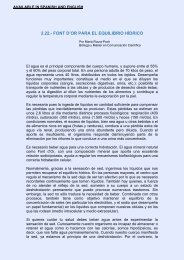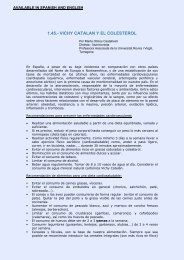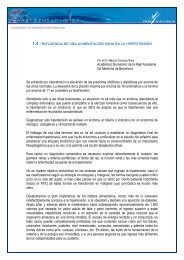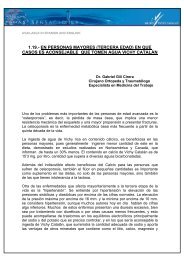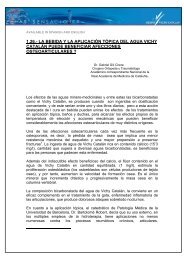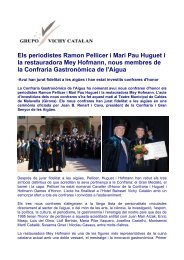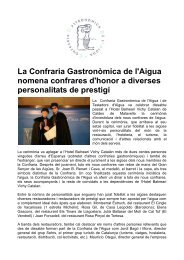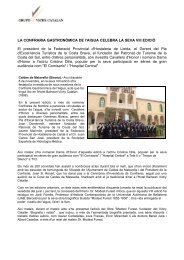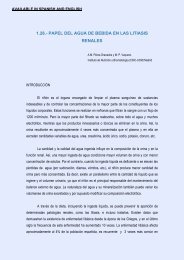importancia del calcio y el magnesio y la relación ... - Vichy Catalan
importancia del calcio y el magnesio y la relación ... - Vichy Catalan
importancia del calcio y el magnesio y la relación ... - Vichy Catalan
You also want an ePaper? Increase the reach of your titles
YUMPU automatically turns print PDFs into web optimized ePapers that Google loves.
AVAILABLE IN SPANISH AND ENGLISH<br />
2.1.- IMPORTANCIA DEL CALCIO Y EL MAGNESIO Y LA RELACIÓN CALCIO-<br />
MAGNESIO EN LAS AGUAS DE BEBIDA<br />
Análisis <strong>d<strong>el</strong></strong> Agua Mineral Natural Fontdor<br />
Por <strong>la</strong> Prof. Josefina San Martín Bacaicoa<br />
CATEDRA DE HIDROLOGIA MEDICA<br />
FACULTAD DE MEDECINA DE MADRID<br />
El organismo humano precisa de sales minerales para atender sus exigencias funcionales<br />
siendo, además, indispensable un adecuado equilibrio iónico o mejor hidro<strong>el</strong>ectrolítico, para que<br />
los fenómenos vitales se produzcan normalmente. Este equilibrio sólo es posible si se mantiene<br />
una exacta compensación de <strong>la</strong>s entradas y salidas de los distintos iones, toda vez que si los<br />
aportes por aparato digestivo son normalmente variables, <strong>el</strong> control renal de <strong>la</strong>s salidas es tan<br />
perfecto que se ha llegado a considerar al riñón como <strong>el</strong> “cerebro <strong>el</strong>ectrolítico <strong>d<strong>el</strong></strong> organismo”<br />
(ORTIZ Y MÉNDEZ, 11).<br />
Entre los principales componentes iónicos <strong>d<strong>el</strong></strong> organismo figuran los cationes: sodio, potasio,<br />
<strong>calcio</strong> y <strong>magnesio</strong>, así como los aniones: cloruro, sulfato y bicarbonato. Todos <strong>el</strong>los deben<br />
mantenerse equilibrados para alcanzar <strong>la</strong> neutralidad, que sólo se logra cuando <strong>la</strong>s cantidades<br />
respectivas de aniones y cationes, expresados en pesos equivalentes, se igua<strong>la</strong>n (MAXWELL Y<br />
KLEEMAN, 10).<br />
La normalidad orgánica precisa no sólo de los factores minerales, sino de un adecuado equilibrio<br />
entre los mismos y así, con r<strong>el</strong>ación al <strong>magnesio</strong>, son de gran interés <strong>la</strong>s acciones directas, pero<br />
no lo son menos <strong>la</strong>s interr<strong>el</strong>acionadas con otros iones, en particu<strong>la</strong>r <strong>el</strong> <strong>calcio</strong>, <strong>el</strong> sodio y <strong>el</strong><br />
potasio. En efecto, <strong>el</strong> <strong>magnesio</strong> cumple un importante pap<strong>el</strong> en <strong>la</strong> formación y función de<br />
múltiples enzimas, fijándose sólidamente en <strong>la</strong> molécu<strong>la</strong> enzimática para originar verdaderas<br />
metaloproteínas (VALLE, 16) o integrarse en <strong>el</strong> complejo metal-enzima o metal-substrato.<br />
Particu<strong>la</strong>rmente destacable es <strong>la</strong> acción activadora <strong>d<strong>el</strong></strong> <strong>magnesio</strong> sobre <strong>la</strong> ATP-asa de <strong>la</strong><br />
membrana c<strong>el</strong>u<strong>la</strong>r y sobre <strong>la</strong>s enzimas que intervienen en <strong>la</strong> fosforilización oxidativa de tanta<br />
trascendencia a niv<strong>el</strong> c<strong>el</strong>u<strong>la</strong>r. Juntamente con <strong>el</strong> <strong>calcio</strong> condiciona los procesos enzimáticos<br />
digestivos (VAN GEERTRUYDEN, 17), sin que esto signifique que ambos iones sean<br />
intercambiables. El <strong>magnesio</strong> interviene activamente en <strong>la</strong> síntesis protéica, en <strong>la</strong> de los ácidos<br />
nucleicos, de <strong>la</strong>s grasas... etc., así como en <strong>la</strong> transmisión <strong>d<strong>el</strong></strong> impulso nervioso, actividad<br />
colinérgica en <strong>el</strong> sistema nervioso central, excitabilidad neuromuscu<strong>la</strong>r, dinámica cardíaca... etc.,<br />
si bien tales efectos estén condicionados en gran parte por <strong>la</strong>s interacciones con otros iones y<br />
así, en cuanto a <strong>la</strong> excitabilidad neuromuscu<strong>la</strong>r son agonistas los iones sodio y potasio y<br />
antagonistas <strong>el</strong> <strong>calcio</strong> y <strong>el</strong> <strong>magnesio</strong>, en tanto que para <strong>la</strong> actividad cardíaca son agonistas <strong>el</strong><br />
sodio y <strong>el</strong> <strong>calcio</strong> y antagonistas <strong>el</strong> potasio y <strong>el</strong> <strong>magnesio</strong> (PEACH, 13; SERRANO, 14; ELKINTON, 7;<br />
DALLEMAGNE, 3 etc.).<br />
En un adulto normal, <strong>el</strong> contenido magnésico es de unos 2.000 mEq (24 g.) de los que un 50%<br />
se encuentra en <strong>la</strong> porción mineral <strong>d<strong>el</strong></strong> tejido óseo, un 45% en <strong>el</strong> medio intrac<strong>el</strong>u<strong>la</strong>r y <strong>el</strong> resto en<br />
los fluidos extrac<strong>el</strong>u<strong>la</strong>res. El <strong>magnesio</strong> <strong>d<strong>el</strong></strong> organismo procede de los aportes alimenticios,<br />
estando facilitada <strong>la</strong> consecución <strong>d<strong>el</strong></strong> mínimo indispensable diario por <strong>la</strong> amplia distribución <strong>d<strong>el</strong></strong><br />
<strong>magnesio</strong> en <strong>la</strong> corteza terrestre de <strong>la</strong> que constituye <strong>el</strong> séptimo <strong>el</strong>emento, siendo <strong>el</strong> cuarto <strong>d<strong>el</strong></strong><br />
p<strong>la</strong>neta y <strong>el</strong> quinto <strong>d<strong>el</strong></strong> Universo (DICKERSON, 6; WACKER Y PARISI, 18).
Es frecuente considerar fuente principal <strong>d<strong>el</strong></strong> <strong>magnesio</strong> en <strong>la</strong> alimentación los vegetales por su<br />
contenido clorofílico; pero los alimentos de mayor riqueza en <strong>magnesio</strong> son los frutos secos tales<br />
como <strong>la</strong>s almendras, <strong>la</strong>s nueces, los cacahuetes, <strong>la</strong>s av<strong>el</strong><strong>la</strong>nas, <strong>el</strong> cacao, los cereales<br />
completos... etc.; entre los alimentos de origen animal más ricos en <strong>magnesio</strong> figuran los quesos,<br />
los moluscos, los crustáceos, los pescados grasos, etc., siendo r<strong>el</strong>ativamente bajo <strong>el</strong> contenido<br />
en <strong>la</strong>s carnes, pescados b<strong>la</strong>ncos, leche y huevos (LAJUSTICIA, 9; PAUL Y SOUTHGATE, 12 etc.).<br />
Por lo que respecta a <strong>la</strong>s aguas, <strong>el</strong> contenido magnésico es dependiente de <strong>la</strong> mineralización <strong>d<strong>el</strong></strong><br />
terreno por <strong>el</strong> que discurren o se estacionan y así, en los sedimentarios <strong>el</strong> origen principal es <strong>la</strong><br />
dolomita; en los ígneos, <strong>el</strong> olivino, <strong>la</strong> biotita, <strong>la</strong> augita... etc.; en los metamórficos, <strong>el</strong> diópsido, <strong>la</strong><br />
serpentina... etc.; pero en todos los casos <strong>la</strong> cantidad de <strong>magnesio</strong> aportado a <strong>la</strong>s aguas es<br />
dependiente de <strong>la</strong> solubilidad de <strong>la</strong>s correspondientes sales y así, <strong>la</strong> <strong>d<strong>el</strong></strong> carbonato magnésico<br />
depende, al menos en parte, <strong>d<strong>el</strong></strong> carbónico libre que pueda contener, pudiendo alcanzar hasta<br />
190 ppm de ion <strong>magnesio</strong> en equilibrio con los carbonatos; los sulfatos y cloruros de <strong>magnesio</strong><br />
son muy solubles y pueden aportar hasta varios miles de partes por millón en equilibrio con los<br />
iones cloruro y sulfato; en <strong>el</strong> caso de los silicatos <strong>el</strong> ataque de los agentes naturales los<br />
desintegra gradualmente facilitando <strong>la</strong> cesión de sus componentes solubles en <strong>el</strong> agua. En<br />
general, <strong>el</strong> contenido en <strong>magnesio</strong> de <strong>la</strong>s aguas superficiales osci<strong>la</strong> entre 1 y 40 ppm, pudiendo<br />
sobrepasar los 100 ppm en <strong>la</strong>s aguas que discurren por terrenos ricos en sales magnésicas<br />
(DAVIS Y DE WIEST, 4). Las aguas marinas contienen una <strong>el</strong>evada cantidad de <strong>magnesio</strong>,<br />
aproximadamente un 4% de <strong>la</strong> mineralización total, siendo por tanto <strong>el</strong> tercero cuantitativamente<br />
de los factores mineralizantes. Según JORDAN (8), cuando <strong>el</strong> contenido salino de <strong>la</strong>s aguas<br />
marinas es de un 35 por decímetro cúbico, <strong>la</strong> concentración de <strong>magnesio</strong> supera <strong>la</strong>s 1.200 ppm.<br />
Para <strong>la</strong>s aguas potables <strong>el</strong> R.D. 1138/1990 de 14 de septiembre, armonizado con <strong>la</strong> Directiva<br />
Comunitaria 80/778/CEE, establece como niv<strong>el</strong> guía 30 mg/l.<br />
Por lo que respecta a <strong>la</strong>s aguas envasadas, regu<strong>la</strong>das por <strong>el</strong> R.D. 1164/1991 de 22 de julio<br />
ajustado a <strong>la</strong> Directiva Comunitaria 80/777/1991 <strong>d<strong>el</strong></strong> Consejo de 15 de julio de 1980 referente a <strong>la</strong><br />
Reg<strong>la</strong>mentación Técnico Sanitaria para <strong>la</strong> <strong>el</strong>aboración, circu<strong>la</strong>ción y comercio de aguas de<br />
bebida envasadas, se especifica para <strong>la</strong>s aguas minerales naturales, <strong>la</strong> mención de magnésicas<br />
si su contenido en <strong>magnesio</strong> es mayor de 50 mg/l y de cálcicas si contiene más de 150 mg/l de<br />
<strong>calcio</strong>.<br />
Para <strong>la</strong>s aguas mineromedicinales no se establecen valores mínimos o máximos para su<br />
contenido en <strong>magnesio</strong>, ni en <strong>calcio</strong>, si bien se consideran magnésicas o cálcicas aqu<strong>el</strong><strong>la</strong>s aguas<br />
cuyo contenido en cada uno de estos componentes supere <strong>el</strong> 20% <strong>d<strong>el</strong></strong> total catiónico expresado<br />
en milivales.<br />
En un estudio, realizado por nosotros hace unos años, sobre <strong>el</strong> contenido de <strong>magnesio</strong> y <strong>calcio</strong> y<br />
<strong>la</strong> r<strong>el</strong>ación <strong>calcio</strong>/<strong>magnesio</strong> en veinticinco aguas minerales envasadas, los valores encontrados<br />
estaban por debajo de los niv<strong>el</strong>es guía que <strong>la</strong> legis<strong>la</strong>ción vigente establece para <strong>la</strong>s aguas<br />
potables de consumo público y de los límites convenientes admitidos para estas aguas.<br />
So<strong>la</strong>mente un agua superaba estos valores.<br />
El agua mineral natural Fontdor que hoy queremos destacar y según los análisis practicados en<br />
<strong>el</strong> Laboratorio <strong>d<strong>el</strong></strong> Dr. Oliver-Rodés (Tab<strong>la</strong>s I y II), los valores encontrados para <strong>el</strong> <strong>magnesio</strong> (2,4
mg/l) y para <strong>el</strong> <strong>calcio</strong> (23,4 mg/l) se encuentran dentro de los niv<strong>el</strong>es guía establecidos para <strong>la</strong>s<br />
aguas potables de consumo público.<br />
ANÁLISIS FÍSICO-QUÍMICO<br />
CARACTERÍSTICAS GENERALES<br />
ASPECTO LÍMPIDO<br />
TURBIDEZ
2.1.- THE IMPORTANCE OF CALCIUM AND MAGNESIUM AND<br />
THE CALCIUM-MAGNESIUM RELATIONSHIP IN DRINKING<br />
WATERS<br />
Analysis of Fontdor natural mineral water<br />
By Dr. Josefina San Martín Bacaicoa.<br />
PROFESSOR OF MEDICAL HYDROLOGY SCHOOL OF MEDICINE<br />
COMPLUTENSE UNIVERSITY OF MADRID<br />
The human body requires mineral salts in order to function, which are also<br />
indispensable for proper ionic or hydro<strong>el</strong>ectrolyte ba<strong>la</strong>nce in order for bodily<br />
phenomena to take p<strong>la</strong>ce normally. This ba<strong>la</strong>nce is only possible if there is an<br />
exact compensation between the intake and output of the different ions; if the<br />
contributions through the digestive tract vary normally, the renal control of<br />
output is so perfect that some have come to consider the kidney the “body’s<br />
<strong>el</strong>ectrolyte brain” (ORTIZ Y MENDEZ, 11).<br />
Among the body’s principal ionic components are cations - sodium, potassium,<br />
calcium and magnesium - as w<strong>el</strong>l as anions - chloride, sulphate and<br />
bicarbonate. They must all be kept ba<strong>la</strong>nced to reach neutrality, which is only<br />
achieved when the respective quantities of anions and cations, expressed in<br />
equivalent weights, are equal (MAXWELL AND KLEEMAN, 10).<br />
Organic normality requires not only mineral factors, but an adequate ba<strong>la</strong>nce<br />
between them. Thus, with r<strong>el</strong>ation to magnesium, the direct actions are of great<br />
interest, although those interr<strong>el</strong>ated with other ions, in particu<strong>la</strong>r calcium,<br />
sodium and potassium, are just as interesting. Indeed, magnesium p<strong>la</strong>ys an<br />
important role in the formation and function of multiple enzymes, attaching<br />
strongly onto the enzyme molecule to form real metalloproteins (VALLE, 16) or<br />
integrating into the metal-enzyme or metal-substrate complex. Particu<strong>la</strong>rly<br />
noteworthy is magnesium’s activating action on the ATPase of the c<strong>el</strong>lu<strong>la</strong>r<br />
membrane and on the enzymes which intervene in the oxidative phosphori<strong>la</strong>tion<br />
which is so important at the c<strong>el</strong>lu<strong>la</strong>r lev<strong>el</strong>. Along with calcium it conditions the<br />
digestive enzymatic processes (VAN GEERTRUYDEN, 17), although this does<br />
not mean that both ions are exchangeable. Magnesium is activ<strong>el</strong>y involved in<br />
protein synthesis and in that of nucleic acids, fats, etc. as w<strong>el</strong>l as in<br />
transmission of nervous impulses, cholinergic activity in the central nervous<br />
system, neuromuscu<strong>la</strong>r excitability, cardiac dynamics, etc. although such effects<br />
are <strong>la</strong>rg<strong>el</strong>y conditioned by interactions with other ions. Thus, for neuromuscu<strong>la</strong>r<br />
excitability sodium and potassium are agonists and calcium and magnesium<br />
antagonists, while for cardiac activity sodium and calcium are agonists and<br />
potassium and magnesium antagonists (PEACH, 13; SERRANO, 14;<br />
ELKINTON, 7; DALLEMAGNE, 3 etc.).
In a normal adult, magnesium content is approximat<strong>el</strong>y 2,000 mEq (24 g.), 50%<br />
of which is found in the mineral portion of the bones, 45% in the intrac<strong>el</strong>lu<strong>la</strong>r<br />
medium and the rest in extrac<strong>el</strong>lu<strong>la</strong>r fluids. The body’s magnesium comes from<br />
food, where obtaining the required daily minimum is facilitated by the ample<br />
distribution of magnesium in the earth’s cortex, in which it is the seventh most<br />
common <strong>el</strong>ement, being the fourth on the p<strong>la</strong>net and the fifth in the Universe<br />
(DICKERSON, 6; WACKERY AND PARISI, 18).<br />
Due to their chlorophyll content, p<strong>la</strong>nts are frequently considered the main<br />
source of dietary magnesium, but the richest foods in magnesium are nuts such<br />
as almonds, walnuts, peanuts, haz<strong>el</strong>nuts, cacao, whole cereals, etc. Among the<br />
food items of an animal origin richest in magnesium are cheese, molluscs,<br />
crustaceans, fatty fish, etc., with r<strong>el</strong>ativ<strong>el</strong>y low contents found in meat, white<br />
fish, milk and eggs (LAJUSTICIA, 9; PAUL AND SOUTHGATE, 12, etc.).<br />
As far as water is concerned, the magnesium content depends on the<br />
mineralization of the <strong>la</strong>nd where it flows or settles and thus in sedimentary rock<br />
the main source is dolomite; in igneous rock, olivine, biotite, augite, etc.; in<br />
metamorphic rock, diopside, serpentine, etc. In all cases the quantity of<br />
magnesium in the water depends on the solubility of the respective salts and,<br />
thus, that of magnesium carbonate depends, at least in part, on the free<br />
carbonic it contains and can reach up to 190 ppm of magnesium ion in<br />
equilibrium with carbonates; magnesium sulphates and chlorides are very<br />
soluble and may contribute up to several thousand parts per million in<br />
equilibrium with the chloride and sulphate ions; in the case of silicates the attack<br />
of natural agents gradually disintegrates them, facilitating the r<strong>el</strong>ease of their<br />
soluble contents into the water. In general, the magnesium content of surface<br />
water varies between 1 an 40 ppm and may exceed 100 ppm in waters which<br />
flow through soil rich in magnesium salts (DAVIS AND DE WIEST, 4). Marine<br />
waters contain high quantities of magnesium, approximat<strong>el</strong>y 4% of total<br />
mineralization, p<strong>la</strong>cing them in third p<strong>la</strong>ce quantitativ<strong>el</strong>y as far as mineralizing<br />
factors. According to JORDAN (8), when the saline content of marine waters is<br />
35 per cubic decimetre, the magnesium concentration exceeds 1.200 ppm.<br />
For drinking water, the R.D. 1138/1990 of 14 th September, adapted to agree<br />
with Community Directive 80/778/EEC, establishes a lev<strong>el</strong> of 30 mg/l. as a<br />
gui<strong>d<strong>el</strong></strong>ine.<br />
As regards bottled waters, regu<strong>la</strong>ted by R.D. 1164/1991 of 22 nd July, adapted to<br />
Community Directive 80/777/1991 of 15 th July 1980, referring to the technical<br />
health regu<strong>la</strong>tions for the preparation, circu<strong>la</strong>tion and trading of bottled drinking<br />
water, mention may be made of magnesium for natural mineral waters if the<br />
magnesium content is greater than 50 mg/l, and of calcium if it contains more<br />
than 150 mg/l of calcium.<br />
No minimum or maximum values of magnesium or calcium content are<br />
established for mineral-medicinal water, although waters in which the contents<br />
of these two components exceed 20% of the cationic total expressed in<br />
millivales are considered magnesic or calcic waters.
In a study we conducted several years ago on the magnesium and calcium<br />
contents and the calcium/magnesium ratio in twenty-five bottled mineral waters,<br />
the values found were b<strong>el</strong>ow the gui<strong>d<strong>el</strong></strong>ine lev<strong>el</strong>s established by current <strong>la</strong>w for<br />
drinking water for public consumption and b<strong>el</strong>ow the recommended limits for<br />
this type of water. Only one water exceeded these values.<br />
According to the tests performed at Laboratorio Dr. Oliver-Rodés (Tables I and<br />
II) on Fontdor natural mineral water, the values found for magnesium (2.4 mg/l)<br />
and calcium (23.4 mg/l) are within the gui<strong>d<strong>el</strong></strong>ine lev<strong>el</strong>s established for drinking<br />
water for public consumption.<br />
Physical-chemical analysis<br />
Appearance<br />
General characteristics<br />
Clear<br />
Turbidity
Table II



